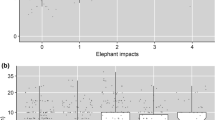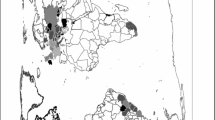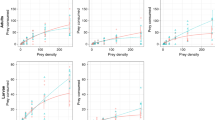Abstract
Invasive alien predators are a serious threat to biodiversity worldwide. However, there is no generic method for assessing which local species are most at risk following the invasion of a new predator. The harlequin ladybird, Harmonia axyridis (Pallas) (Coleoptera: Coccinellidae), is an alien in Europe and many other parts of the world where it affects other species of ladybirds through competition for food and intra-guild predation (IGP). Here, we describe a method developed to assess which European ladybird species are most at risk following the invasion of H. axyridis. The three components of the risk assessment are: the likelihood that the assessed native species encounters H. axyridis in the field, the hazard of competition for food, and the IGP hazard. Thirty native European ladybird species were assessed through data obtained from field observations, laboratory experiments and literature reviews. The species that are considered most at risk are found on deciduous trees, have immature stages which are highly vulnerable to IGP by H. axyridis, and are primarily aphidophagous. These species should be the focus of specific studies and possibly conservation actions. The risk assessment method proposed here could be applied to other alien predators which are considered a threat to native species through competition and predation.
Similar content being viewed by others

References
Adriaens T, Martin San, y Gomez G, Maes D (2008) Invasion history, habitat preferences and phenology of the invasive ladybird Harmonia axyridis in Belgium. BioControl 53:69–88
Adriaens T, San Martin y Gomez G, Maes D, Brosens D, Desmet P (2012) Belgian Coccinellidae—Ladybird beetles in Belgium. v1.0. Research Institute for Nature and Forest (INBO). Dataset/Occurrence. http://doi.org/10.15468/0refva. Accessed 15 Mar 2016
Adriaens T, Martin S, y Gomez G, Bogaert J, Crevecoeur L, Beuckx J-P, Maes D (2015) Testing the applicability of regional IUCN Red List criteria on ladybirds (Coleoptera, Coccinellidae) in Flanders (north Belgium): opportunities for Conservation. Insect Conserv Divers 8:404–417
Bahlai CA, Colunga-Garcia M, Gage SH, Landis DA (2015) The role of exotic ladybeetles in the decline of native ladybeetle populations: evidence from long-term monitoring. Biol Invasions 17:1005–1024
Beggs JR, Brockerhoff EG, Corley JC, Kenis M, Masciocchi M, Muller F, Rome Q, Villemant C (2011) Ecological effects and management of invasive alien Vespidae. BioControl 56:505–526
Bellard C, Cassey P, Blackburn TM (2016) Alien species as a driver of recent extinctions. Biol Lett 12:20150623
Brown PMJ, Frost R, Dobersk J, Sparks T, Harrington R, Roy HE (2011) Decline in native ladybirds in response to the arrival of Harmonia axyridis: early evidence from England. Ecol Entomol 36:231–240
Brown PMJ, Ingels B, Wheatley A, Rhule EL, de Clercq P, van Leeuwen T, Thomas A (2015) Intraguild predation by Harmonia axyridis (Coleoptera: Coccinellidae) on native insects in Europe: molecular detection from field samples. Entomol Sci 18:130–133
Colunga-Garcia M, Gage SH (1998) Arrival, establishment, and habitat use of the multicolored Asian lady beetle (Coleoptera: Coccinellidae) in a Michigan landscape. Environ Entomol 27:1574–1580
Comont RF, Roy HE, Harrington R, Shortall CR, Purse BV (2014) Ecological correlates of local extinction and colonisation in the British ladybird beetles (Coleoptera: Coccinellidae). Biol Invasions 16:1805–1817
D’hondt B, Vanderhoeven S, Roelandt S, Mayer F, Versteirt V, Adriaens T, Ducheyne E, San Martin G, Grégoire JC, Stiers I, Quoilin S, Cigar J, Heughebaert A, Branquart E (2015) Harmonia+ and Pandora+: risk screening tools for potentially invasive plants, animals and their pathogens. Biol Invasions 17:1869–1883
Eschen R, Babendreier D, Nauer S, Bigler F, Kenis M (2007) Surveys for ladybirds (Coleoptera: Coccinellidae) in Switzerland and confirmation of the presence of the invasive alien ladybird species Harmonia axyridis (Pallas). Mitt Schweiz Entomol Ges 80:7–14
Félix S, Soares AO (2004) Intraguild predation between the aphidophagous ladybird beetles Harmonia axyridis and Coccinella undecimpunctata (Coleoptera: Coccinellidae): the role of body weight. Eur J Entomol 101:237–242
Hajek AE, Hurley BP, Kenis M, Garnas JR, Bush SJ, Wingfield MJ, van Lenteren JC, Cock MJ (2016) Exotic biological control agents: a solution or contribution to arthropod invasions? Biol Invasions 18:953–969
Harmon JP, Stephens E, Losey J (2007) The decline of native coccinellids (Coleoptera: Coccinellidae) in the United States and Canada. J Insect Conserv 11:85–94
Harris R, Abbott K, Barton K, Berry J, Don W, Gunawardana D, Lester P, Rees J, Stanley M, Sutherland A, Toft R (2005) Invasive ant pest risk assessment project for Biosecurity New Zealand. Series of unpublished Landcare Research contract reports to Biosecurity New Zealand. BAH/35/2004-1
Hautier L (2012) Intraguild predation in Harmonia axyridis and its effects on native coccinellids. PhD thesis, Université Libre de Bruxelles, Belgium
Hautier L, Martin San, y Gomez G, Callier P, de Biseau J, Gregoire J (2011) Alkaloids provide evidence of intraguild predation on native coccinellids by Harmonia axyridis in the field. Biol Invasions 13:1805–1814
Hodek I, Evans EW (2012) Food relationships. In: Hodek I, van Emden HF, Honek A (eds) Ecology and behaviour of the ladybird beetles (Coccinellidae). Wiley-Blackwell, Chichester, pp 141–274
Hodek I, van Emden HF, Honek A (2012) Ecology and behaviour of the ladybird beetles (Coccinellidae). Wiley-Blackwell, Chichester
Holway DA, Lach L, Suarez A, Tsutsui N, Case TJ (2002) The causes and consequences of ant invasions. Annu Rev Ecol Syst 33:181–233
Hulme P, Bacher S, Kenis M, Klotz S, Kuhn I, Minchin D, Nentwig W, Olenin S, Panov V, Pergl J, Pysek P, Roques A, Sol D, Solarz W, Vila M (2008) Grasping at the routes of biological invasions: a framework for integrating pathways into policy. J Appl Ecol 45:403–414
Jansen J-P, Hautier L (2008) Ladybird population dynamics in potato: comparison of native species with an invasive species, Harmonia axyridis. BioControl 53:223–234
Katsanis A, Babendreier D, Nentwig W, Kenis M (2013) Intraguild predation between the invasive ladybird Harmonia axyridis and non-target European coccinellid species. BioControl 58:73–83
Katsanis A, Magro A, Ramon-Portugal F, Kenis M, Babendreier D (2016) Chemical defences of native European coccinellid eggs against intraguild predation by the invasive Asian coccinellid, Harmonia axyridis (Pallas). BioControl, this issue
Kenis M, Auger-Rozenberg M-A, Roques A, Timms L, Péré C, Cock MJW, Settele J, Augustin S, Lopez-Vaamonde C (2009) Ecological effects of invasive alien insects. Biol Invasions 11:21–45
Koch RL, Hutchison WD, Venette RC, Heimpel GE (2003) Susceptibility of immature monarch butterfly, Danaus plexippus (Lepidoptera: Nymphalidae: Danainae), to predation by Harmonia axyridis (Coleoptera: Coccinellidae). Biol Control 28:265–270
Koch RL, Venette RC, Hutchison WD (2006) Predicted impact of an exotic generalist predator on monarch butterfly (Lepidoptera: Nymphalidae) populations: a quantitative risk assessment. Biol Invasions 8:1179–1193
Kumschick S, Richardson DM (2013) Species-based risk assessments for biological invasions: Advances and challenges. Divers Distrib 19:1095–1105
Kumschick S, Bacher S, Marková Z, Pergl J, Pyšek P, Vaes-Petignat S, van der Veer G, Vilà M, Nentwig W (2015) Comparing impacts of alien plants and animals using a standard scoring system. J Appl Ecol 52:552–561
Long JL (2003) Introduced mammals of the world. Their history distribution and influence. CABI, Wallingford
MacNeil C, Plavoet D, Dick JTA, Fielding N, Constable A, Hall N, Aldridge D, Renals T, Diamond M (2010) The Ponto-Caspian ‘killer shrimp’, Dikerogammarus villosus (Sowinsky, 1894), invades the British Isles. Aquat Invasions 5:441–445
Majerus MEN (1994) Ladybirds (No. 81, New Naturalist Series). HarperCollins, London
Michaud JP (2002) Invasion of the Florida citrus ecosystem by Harmonia axyridis (Coleoptera : Coccinellidae) and asymmetric competition with a native species, Cycloneda sanguinea. Environ Entomol 31:827–835
Nóia M, Borges I, Soares AO (2008) Intraguild predation between the aphidophagous ladybird beetles Harmonia axyridis and Coccinella undecimpunctata (Coleoptera: Coccinellidae): the role of intra and extraguild prey densities. Biol Control 46:140–146
Pell JK, Baverstock J, Roy HE, Ware RL, Majerus MEN (2008) Intraguild predation involving Harmonia axyridis: a review of current knowledge and future perspectives. BioControl 53:147–168
Polis GA, Myers CA, Holt RD (1989) The ecology and evolution of intraguild predation: potential competitors that eat each other. Annu Rev Ecol Syst 20:297–330
Raak-van den Berg CL, De Lange HJ, van Lenteren JC (2012) Intraguild predation behaviour of ladybirds in semi-field experiments explains invasion success of Harmonia axyridis. PLoS ONE 7(7):e40681
Rondoni G, Onofri A, Ricci C (2012a) Laboratory studies on intraguild predation and cannibalism among coccinellid larvae (Coleoptera: Coccinellidae). Eur J Entomol 109:353–362
Rondoni G, Onofri A, Ricci C (2012b) Differential susceptibility in a specialised aphidophagous ladybird, Platynaspis luteorubra (Coleoptera: Coccinellidae), facing intraguild predation by exotic and native generalist predators. Biocontrol Sci Technol 22:1334–1350
Rondoni G, Athey KJ, Harwood JD, Conti E, Ricci C, Obrycki JJ (2014) Development and application of molecular gut-content analysis to detect aphid and coccinellid predation by Harmonia axyridis (Coleoptera: Coccinellidae) in Italy. Insect Sci 22:719–730
Roy HE, Brown PMJ, Frost R, Poland RL (2011) Ladybirds (Coccinellidae) of Britain and Ireland. NERC Centre for Ecology & Hydrology, Wallingford
Roy HE, Adriaens T, Isaac NJB, Kenis M, Onkelinx T, San Martin G, Brown PMJ, Hautier L, Poland R, Roy DB, Comont R, Eschen R, Frost R, Zindel R, van Vlaenderen J, Nedvěd O, Ravn HP, Grégoire J-C, de Biseau J-C, Maes D (2012) Invasive alien predator causes rapid declines of native European ladybirds. Divers Distrib 18:717–725
Roy HE, Brown PMJ, Adriaens T, Berkvens N, Borges I, Clusella-Trullas S, De Clercq P, Comont RF, Eschen R, Estoup A, Evans EW, Facon B, Gardiner MM, Gil A, Grez AA, Guillemaud T, Haelewaters D, Herz A, Honek A, Howe AG, Hui C, Hutchison WD, Kenis M, Koch RL, Kulfan J, Lawson Handley L, Lombaert E, Loomans A, Losey J, Lukashuk AO, Maes D, Magro A, Murray KM, San Martin G, Martinkova Z, Minnaar IA, Nedved O, Orlova-Bienkowskaja MJ, Rabitsch W, Ravn HP, Rondoni G, Rorke SL, Ryndevich SK, Saethre M-G, Sloggett JJ, Soares AO, Stals R, Tinsley MC, Vandereycken A, van Wielink P, Viglášová S, Zach P, Zakharov IA, Zaviezo T, Zhao Z (2016) The harlequin ladybird. Harmonia axyridis: global perspectives on invasion history and ecology. Biol Invasions 18:997
Sato S, Yasuda H, Evans EW (2005) Dropping behaviour of larvae of aphidophagous ladybirds and its effects on incidence of intraguild predation: interactions between the intraguild prey, Adalia bipunctata (L.) and Coccinella septempunctata (L.), and the intraguild predator, Harmonia axyridis Pallas. Ecol Entomol 30:220–224
Snyder WE, Evans EW (2006) Ecological effects of invasive arthropod generalist predators. Annu Rev Ecol Evol Syst 37:95–122
Soares AO, Serpa A (2007) Interference competition between ladybird beetle adults (Coleoptera: Coccinellidae): effects on the growth and reproductive capacity. Pop Ecol 49:37–43
Thomas A, Trotman J, Wheatley A, Aebi A, Zindel R, Brown PMJ (2013) Predation of native coccinellids by the invasive alien Harmonia axyridis (Coleoptera: Coccinellidae): detection in Britain by PCR based gut analysis. Insect Conserv Divers 6:20–27
van Lenteren JC, Bale JS, Bigler F, Hokkanen HMT, Loomans AJM (2006) Assessing risks of releasing exotic biological control agents of arthropod pests. Annu Rev Entomol 51:609–634
Wagner DL, van Driesche RG (2010) Threats posed to rare or endangered insects by invasions of nonnative species. Annu Rev Entomol 55:547–568
Ware RL, Majerus MEN (2008) Intraguild predation of immature stages of British and Japanese coccinellids by the invasive ladybird Harmonia axyridis. BioControl 53:169–188
Ware RL, Evans N, O’Farrell K, Majerus MEN, Malpas L, Michie LJ (2008a) Intraguild predation of British and Japanese coccinellid eggs by the invasive ladybird Harmonia axyridis. Neobiota 7:263–275
Ware RL, Ramon-Portugal F, Magro A, Ducamp C, Hemptinne J-L, Majerus MEN (2008b) Chemical protection of Calvia quatuordecimguttata eggs against intraguild predation by the invasive ladybird Harmonia axyridis. BioControl 53:189–200
Zindel R (2008) The potential impact of an exotic ladybird, Harmonia axyridis (Pallas), on native species in Switzerland. Master Thesis, University of Fribourg, Switzerland
Acknowledgments
The authors acknowledge the help and support of I. Wright and L.-J. Michie, formerly of the Department of Genetics, University of Cambridge, UK. The work in Switzerland was supported by the EU project ALARM (GOCE-CT-2003-506675) and GRANTs from the Swiss Federal Office for the Environment (F232-0377) and the Swiss National Science Foundation (3100A0-117831). HER is supported by the Natural Environment Research Council, Joint Nature Conservation Committee and the Department for the Environment, Food and Rural Affairs. We are very grateful to all the recorders contributing records to the national surveys in Britain and Belgium.
Author information
Authors and Affiliations
Corresponding author
Additional information
Handling Editor: Lori-Jayne Lawson Handley
Rights and permissions
About this article
Cite this article
Kenis, M., Adriaens, T., Brown, P.M.J. et al. Assessing the ecological risk posed by a recently established invasive alien predator: Harmonia axyridis as a case study. BioControl 62, 341–354 (2017). https://doi.org/10.1007/s10526-016-9764-x
Received:
Accepted:
Published:
Issue Date:
DOI: https://doi.org/10.1007/s10526-016-9764-x



